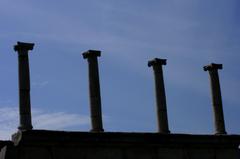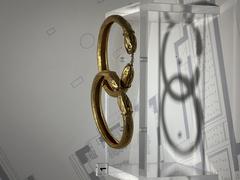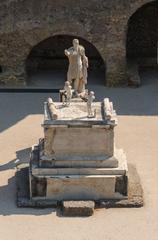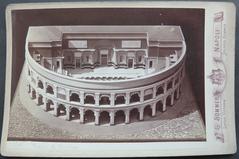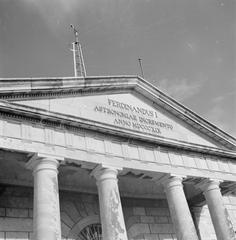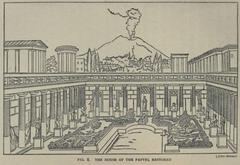Temple of Venus Herculaneum: Visiting Hours, Tickets, and Historical Significance
Date: 03/07/2025
Introduction
Nestled on the Bay of Naples, the ancient Roman city of Herculaneum offers a unique window into antiquity, preserved under volcanic ash from the eruption of Mount Vesuvius in 79 CE. Among its most evocative monuments is the Temple of Venus, a testament to the city’s religious, cultural, and artistic life. This guide provides essential information on the Temple of Venus at Herculaneum—its history, architectural features, visitor information, and travel tips—to help you make the most of your visit to this UNESCO World Heritage Site. For the latest updates, consult resources like Pompeii Archaeological Park, NaplesWise, and CoopCulture.
The Origins and Development of Herculaneum
Founded by the Oscans and later influenced by Etruscan, Greek, and Roman cultures, Herculaneum (Heraklion) was a prosperous trading hub from the 4th century BCE. Its multicultural heritage is evident in its religious architecture and traditions, blending Italic, Greek, and Roman influences (Wikipedia; UNRV; Roman Empire History).
After becoming a Roman municipium in 89 BCE, Herculaneum flourished as an elite resort town. Grand villas, intricate mosaics, and advanced infrastructure—including the Serino aqueduct—demonstrated its wealth and importance (Roman Empire History; World History Encyclopedia; Visit Pompei Vesuvius).
The Religious Landscape and the Cult of Venus
Herculaneum’s religious life fused local and imported traditions, with deities like Hercules, Mercury, Neptune, Minerva, and especially Venus playing prominent roles. The cult of Venus Erycina, with origins in Oscan worship, was central to the city’s identity (Pompeii Archaeological Park).
The Sacred Area and the Temple of Venus
The Sacred Area Terrace, accessible from Cardo IV, became the heart of Venus worship. The modest yet elegant temple was rebuilt after the 62 CE earthquake, with benefactors’ dedications revealing both religious devotion and imperial connections. Notable features include a white mosaic floor with black borders, painted walls and ceiling, and a vaulted roof. Donations of imperial busts, recorded in inscriptions, hint at the intertwining of local and imperial cults (Herculaneum UK).
The Shrine of the Four Gods
Adjacent to the Temple of Venus is the Shrine of the Four Gods, restored after the earthquake and adorned with reliefs of Minerva, Neptune, Mercury, and Vulcan—deities linked to trade and craftsmanship. The shrine’s architecture, including cipollino marble and opus sectile flooring, and rare preserved wooden roofing, offer valuable insights into Roman building techniques (Herculaneum UK).
The Eruption of 79 CE and Preservation
Mount Vesuvius’s eruption buried Herculaneum beneath up to 20 meters of volcanic material, preserving organic materials, frescoes, and architecture with exceptional fidelity. The Sacred Area, including the Temple of Venus, survived remarkably intact, providing an unparalleled archaeological record (Wikipedia; History Skills; Visit Pompei Vesuvius).
Rediscovery and Archaeological Significance
Rediscovered in 1709, Herculaneum has been the focus of systematic excavation since 1738, though much remains buried under modern Ercolano (Wikipedia; Helen on Her Holidays). The Temple of Venus and its surroundings are vital for understanding the city’s religious and civic life, as well as the blending of cultural traditions (Pompeii Archaeological Park).
Visitor Information: Hours, Tickets, and Essential Tips
Location and Access
The Temple of Venus is located within the Herculaneum Archaeological Park in Ercolano, near Naples. The main entrance is on Corso Resina.
- By Train: Circumvesuviana line to Ercolano Scavi station (10-minute walk).
- By Car: Limited parking nearby.
Opening Hours
- April–October: 8:30 AM–7:30 PM (last entry 6:00 PM)
- November–March: 8:30 AM–5:00 PM (last entry 3:30 PM)
- Closed: January 1 and December 25
Confirm current hours before visiting on CoopCulture.
Tickets and Booking
- Standard admission: €13 (discounts for EU citizens 18–25; free for children under 18)
- Purchase: Online (recommended in high season), or onsite. Use the CoopCulture website for advance tickets.
- Campania Arte Card: Accepted for savings and priority access.
Accessibility
- Routes: Smooth main streets, ramps, and bridges connect key areas, including the Temple of Venus.
- Wheelchair Users: Free entry for visitors with disabilities and a companion (with documentation). Accessibility map available.
- Facilities: Accessible bathrooms at the entrance. Adapted taxis and tours can be arranged in advance.
Guided Tours and Audio Guides
- Official guides and audio guides available at the entrance.
- Specialized tours focus on art, religion, and daily life in Herculaneum.
Visitor Tips
- Best Time to Visit: Early morning or late afternoon, especially outside peak April–October season.
- Duration: 2–3 hours recommended for a thorough visit.
- What to Bring: Comfortable shoes, water, sun protection in summer, waterproof jackets in winter.
- Facilities: Restrooms and a small refreshment area above the ruins; no vendors inside the park.
- Bag Storage: Free at the ticket office.
- Photography: Allowed for personal use; tripods/drones require permission.
Exploring Nearby Attractions
- Pompeii Archaeological Park: Easily reached via Circumvesuviana train.
- Mount Vesuvius National Park: Hike to the crater; buses depart from Ercolano.
- Virtual Archaeological Museum (MAV): Interactive exhibits and VR reconstructions.
- Naples: Museums, historic sites, and vibrant street life.
Notable Artifacts and Museum Connections
Artifacts from the Temple of Venus and Sacred Area are displayed at the on-site museum and the National Archaeological Museum in Naples, including statues, fresco fragments, and religious objects (My Flying Leap).
Preservation Challenges and Ongoing Research
Only a fraction of Herculaneum is excavated; much remains under modern Ercolano. Preservation focuses on stabilizing structures and protecting frescoes, while ongoing research continues to reveal new insights into Roman religious life (NaplesWise).
Frequently Asked Questions (FAQ)
Q: What are the visiting hours for the Temple of Venus?
A: 8:30 AM–7:30 PM (April–October), 8:30 AM–5:00 PM (November–March). Confirm on CoopCulture.
Q: How do I buy tickets?
A: Online via CoopCulture or onsite; advance booking recommended in peak season.
Q: Is the site accessible for visitors with disabilities?
A: Yes, designated routes and facilities are available.
Q: Can I combine my visit with other sites?
A: Yes, Herculaneum is well connected to Pompeii and Mount Vesuvius.
Q: Are guided tours available?
A: Yes, bookable at the entrance or in advance.
Visual Highlights
Alt text: Temple of Venus at Herculaneum archaeological site showcasing Roman architecture and frescoes.
Alt text: Map of Herculaneum Archaeological Park with the Temple of Venus location highlighted.
Essential Visitor Tips
- Arrive early or late for a quieter experience.
- Purchase tickets in advance during peak months.
- Wear sturdy footwear and bring water.
- Use accessible paths if needed.
- Consider guided or audio tours for deeper context.
- Check CoopCulture for updates.
Call to Action
Ready to explore the Temple of Venus and the wonders of Herculaneum? Download the Audiala app for audio guides, plan your visit with our website’s resources, and follow us on social media for the latest updates and offers.
Related Articles:
- Top 10 Must-See Sites in Herculaneum
- Mount Vesuvius Hiking Guide
- History of Roman Temples in Campania
Summary
The Temple of Venus at Herculaneum offers an immersive journey into Roman religious and civic life, with its architectural elegance and preserved art providing unrivaled insights. Practical information on visiting hours, ticketing, and accessibility ensures an enriching experience. Its proximity to Pompeii, Mount Vesuvius, and Naples makes Herculaneum an essential stop for any traveler in southern Italy. For a deeper exploration, utilize guided tours, audio guides, and authoritative resources like NaplesWise, My Flying Leap, and CoopCulture.
References
- “Herculaneum,” 2024, Wikipedia (https://en.wikipedia.org/wiki/Herculaneum)
- “Visiting Herculaneum: Temple of Venus, Tickets, Hours, and Historical Insights,” 2025, Pompeii Archaeological Park (https://pompeiiarchaeologicalpark.com/venus-erycina/)
- “How to Visit Herculaneum: Our Complete Guide,” 2025, NaplesWise (https://napleswise.com/herculaneum/how-to-visit-herculaneum-our-complete-guide/)
- “Herculaneum Ruins: A Complete Visitor’s Guide,” 2025, My Flying Leap (https://myflyingleap.com/italy/herculaneum-ruins/)
- “Visiting the Temple of Venus at Herculaneum: History, Tickets, and Tips,” 2025, Marked by Teachers (https://www.markedbyteachers.com/as-and-a-level/history/religion-in-pompeii-and-herculaneum.html)
- “Temple of Venus at Herculaneum: Visitor Information,” 2025, CoopCulture (https://www.coopculture.it/en/heritage.cfm?id=74)
- “A Guide to Visiting Herculaneum Including Highlights,” 2024, Whats Down That Street (https://whatsdownthatstreet.com/2024/10/24/a-guide-to-visiting-herculaneum-including-highlights/)
